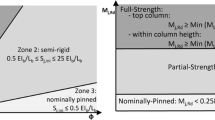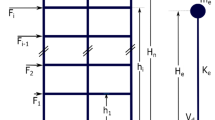Abstract
While quite extensive research has been undertaken during the last decades to extend the direct displacement-based design (DDBD) method to a wide range of structural types and materials, it is recognized that there are still some areas requiring further study and development. Steel structures and, more specifically, steel moment resisting frames with setbacks are one of these and, therefore, this work aims to investigate the seismic response of such structures designed according to the DDBD procedure currently prescribed for regular frames and to elaborate specific recommendations based on the results obtained. The main aspects to be considered are the adequacy of the displacement profile and higher mode reduction factor to be used, as well as the suitable strength distribution required. In a trial application of the current DDBD procedure, two two-dimensional 12-storey frames with setbacks are designed, and the solutions obtained are used to develop models of the structures, which are then subject to a series of non-linear time-history analyses at increasing levels of intensity, using spectrum-compatible scaled accelerograms. The results obtained are contrasted with those of Karavasilis et al. (J Constr Steel Res 64:644–654, 2008), which were developed for steel frames designed via code methods. It is recognized that the DDBD method can benefit from the expressions developed by these authors, and recommendations for the adjustment of the DDBD higher mode reduction factors are subsequently proposed. The efficacy of the latter is evaluated by the design and verification at a range of diverse intensities of a set of two-dimensional frames of 6, 9 and 12 storeys, and satisfactory outcomes are obtained. These results have been fundamental in revealing the need for future research regarding the influence of the design spectral shapes, ductility demand and P-Delta instability in the dynamic amplification of drifts due to higher mode effects.

















Similar content being viewed by others
References
Bommer JJ, Stafford PJ, Akkar S (2010) Current empirical ground-motion prediction equations for Europe and their application to Eurocode 8. Bull Earthq Eng 8(1):5–26
Boore DN, Bommer JJ (2005) Processing of strong-motion accelerograms: needs, options and consequences. Soil Dyn Earthq Eng 25:93–115
Carr AJ (2011) Ruaumoko 3D software. University of Canterbury, Christchurch
CEN (2004) Eurocode 8: design of structures for earthquake resistance—part 1: general rules, seismic actions and rules for buildings. European Committee for Standardization, Brussels
CEN (2010) Eurocode 3: design of steel structures—part 1-1: general rules and rules for buildings. European Committee for Standardization, Brussels
Chen WF, Atsuta T (2008) Theory of beam-columns—volume 2: space behavior and design. J. Ross Publishing, Florida
De Stefano M, Pintucchi B (2007) A review of research on seismic behaviour of irregular building structures since 2002. Bull Earthq Eng 6:285–308
FEMA (1997) NEHRP guidelines for the seismic rehabilitation of buildings, FEMA 273. Federal Emergency Management Agency, Washington D.C.
García R, Sullivan TJ, Della Corte G (2010) Development of a displacement-based design method for steel frame-RC wall buildings. J Earthq Eng 14(2):252–277
Karavasilis TL, Bazeos N, Beskos DE (2008) Seismic response of plane steel MRF with setbacks: estimation of inelastic deformation demands. J Constr Steel Res 64:644–654
Maley TJ (2011) Seismic design of mixed MRF systems. Ph.D. Dissertation, European School for Advanced Studies in Reduction of Seismic Risk (ROSE School), IUSS Pavia, Italy
Maley TJ, Sullivan TJ, Della Corte G (2010) Development of a displacement-based design method for steel dual systems with buckling-restrained braces and moment resisting frames. J Earthq Eng 14(1):106–140
Maley T, Sullivan T, Lago A, Roldán R, Calvi GM (2013) Characterising the seismic behaviour of steel MRF structures. Research report EUCENTRE—2013/02, IUSS Press, Pavia, Italy
Mazzolani FM, Piluso V (1996) Theory and design of seismic resistant steel frames. E & FN Spon, an Imprint of Chapman & Hall, London
Nievas CI (2013) Direct displacement-based design of steel moment resisting frames with setbacks. M.Sc. Dissertation, Understanding and Managing Extremes (UME) School, Istituto Universitario di Studi Superiori di Pavia - Università degli Studi di Pavia, Italy
Pennucci D, Calvi GM, Sullivan TJ (2009) Displacement-based design of precast walls with additional dampers. J Earthq Eng 13(1):40–65
Pennucci D, Sullivan TJ, Calvi GM (2011) Displacement reduction factors for the design of medium and long-period structures. J Earthq Eng 15(1):1–29
Pettinga JD, Priestley MJN (2005) Dynamic behaviour of reinforced concrete frames designed with direct displacement-based design. Research report ROSE—2005/02, IUSS Press, Pavia, Italy
Priestley MJN (2003) Does capacity design do the job? An examination of higher mode effects in cantilever walls. Bull N Z Soc Earthq Eng 36(4):276–292
Priestley MJN, Calvi GM, Kowalsky MJ (2007) Displacement-based seismic design of structures. IUSS Press, Pavia
Smyrou E, Sullivan TJ, Priestley MJN, Calvi GM (2008) Dynamic behaviour if T-shaped RC walls designed with direct displacement-based design. In: 14th World conference on earthquake engineering, Beijing, China
Sullivan TJ (2009) Direct displacement-based design of a RC wall-steel EBF dual system with added dampers. Bull N Z Soc Earthq Eng 42(3):167–178
Sullivan TJ (2013a) Direct displacement-based seismic design of steel eccentrically braced frame structures. Bull Earthq Eng 11(6):2197–2231
Sullivan TJ (2013b) Highlighting differences between force-based and displacement-based design solutions for RC frame structures. Struct Eng Int 23(2):122–131
Sullivan TJ, Lago A (2012) Towards a simplified direct DBD procedure for the seismic design of moment resisting frames with viscous dampers. Eng Struct 35:140–148
Sullivan TJ, Priestley MJN, Calvi GM (2006) Seismic design of frame-wall structures. Research report ROSE-2006/02, IUSS Press, Pavia, Italy
Sullivan TJ, Priestley MJN, Calvi GM (2008) Estimating the Higher-mode response of ductile structures. J Earthq Eng 12(3):456–472
Sullivan TJ, Maley T, Calvi GM (2011) Seismic response of steel moment resisting frames designed using a direct DBD procedure. In: Proceedings of the 8th international conference on structural dynamics, EURODYN 2011, Leuven, Belgium
Sullivan TJ, Priestley MJN, Calvi GM (2012) A model code for the displacement-based seismic design of structures—DBD12. IUSS Press, Pavia
Weatherill G, Danciu L, Crowley H (2013) Future directions for seismic input in European design codes in the context of the seismic hazard harmonisation in Europe (SHARE) project. In: Vienna congress on recent advances in earthquake engineering and structural dynamics (VEESD) 2013, Vienna, Austria
Acknowledgments
This research is the result of part of the first author’s M.Sc. research at the Masters in Earthquake Engineering and Engineering Seismology (MEEES) Erasmus-Mundus programme of UME School, Istituto Universitario di Studi Superiori (IUSS) Pavia, Italy. The authors also gratefully acknowledge that part of the research leading to these results has also received funding from the European Community’s Research Fund for Coal and Steel (RFCS) under Grant agreement no. [RFSR-CT-2010-00029]. The authors are thankful to Dr. Vitor Silva and the two anonymous reviewers whose comments during the drafting of this manuscript and its revision stage, respectively, have been of great value for improving the quality of the paper.
Author information
Authors and Affiliations
Corresponding author
Rights and permissions
About this article
Cite this article
Nievas, C.I., Sullivan, T.J. Applicability of the direct displacement-based design method to steel moment resisting frames with setbacks. Bull Earthquake Eng 13, 3841–3870 (2015). https://doi.org/10.1007/s10518-015-9787-1
Received:
Accepted:
Published:
Issue Date:
DOI: https://doi.org/10.1007/s10518-015-9787-1




